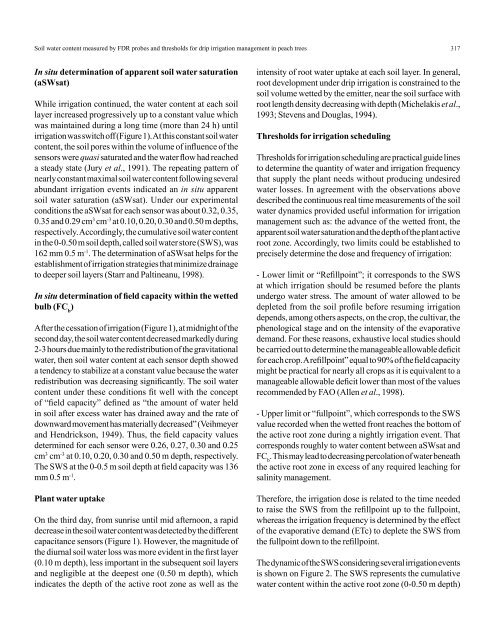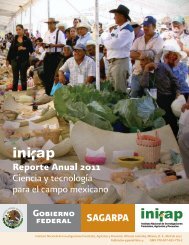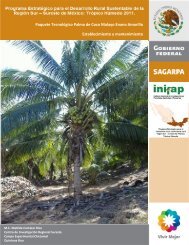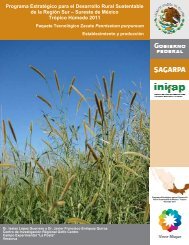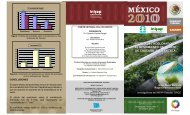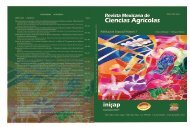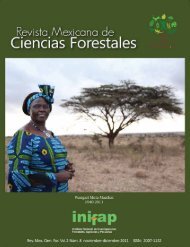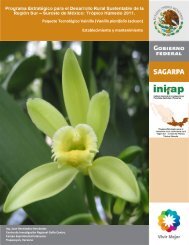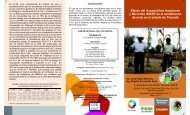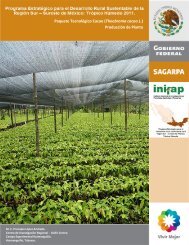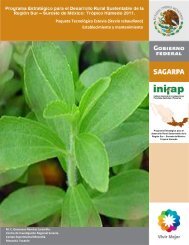Vol. 34 Núm. 3 - Instituto Nacional de Investigaciones Forestales ...
Vol. 34 Núm. 3 - Instituto Nacional de Investigaciones Forestales ...
Vol. 34 Núm. 3 - Instituto Nacional de Investigaciones Forestales ...
Create successful ePaper yourself
Turn your PDF publications into a flip-book with our unique Google optimized e-Paper software.
Soil water content measured by FDR probes and thresholds for drip irrigation management in peach trees 317In situ <strong>de</strong>termination of apparent soil water saturation(aSWsat)While irrigation continued, the water content at each soillayer increased progressively up to a constant value whichwas maintained during a long time (more than 24 h) untilirrigation was switch off (Figure 1). At this constant soil watercontent, the soil pores within the volume of influence of thesensors were quasi saturated and the water flow had reacheda steady state (Jury et al., 1991). The repeating pattern ofnearly constant maximal soil water content following severalabundant irrigation events indicated an in situ apparentsoil water saturation (aSWsat). Un<strong>de</strong>r our experimentalconditions the aSWsat for each sensor was about 0.32, 0.35,0.35 and 0.29 cm 3 cm -3 at 0.10, 0.20, 0.30 and 0.50 m <strong>de</strong>pths,respectively. Accordingly, the cumulative soil water contentin the 0-0.50 m soil <strong>de</strong>pth, called soil water store (SWS), was162 mm 0.5 m -1 . The <strong>de</strong>termination of aSWsat helps for theestablishment of irrigation strategies that minimize drainageto <strong>de</strong>eper soil layers (Starr and Paltineanu, 1998).In situ <strong>de</strong>termination of field capacity within the wettedbulb (FC b)After the cessation of irrigation (Figure 1), at midnight of thesecond day, the soil water content <strong>de</strong>creased markedly during2-3 hours due mainly to the redistribution of the gravitationalwater, then soil water content at each sensor <strong>de</strong>pth showeda ten<strong>de</strong>ncy to stabilize at a constant value because the waterredistribution was <strong>de</strong>creasing significantly. The soil watercontent un<strong>de</strong>r these conditions fit well with the conceptof “field capacity” <strong>de</strong>fined as “the amount of water heldin soil after excess water has drained away and the rate ofdownward movement has materially <strong>de</strong>creased” (Veihmeyerand Hendrickson, 1949). Thus, the field capacity values<strong>de</strong>termined for each sensor were 0.26, 0.27, 0.30 and 0.25cm 3 cm -3 at 0.10, 0.20, 0.30 and 0.50 m <strong>de</strong>pth, respectively.The SWS at the 0-0.5 m soil <strong>de</strong>pth at field capacity was 136mm 0.5 m -1 .Plant water uptakeOn the third day, from sunrise until mid afternoon, a rapid<strong>de</strong>crease in the soil water content was <strong>de</strong>tected by the differentcapacitance sensors (Figure 1). However, the magnitu<strong>de</strong> ofthe diurnal soil water loss was more evi<strong>de</strong>nt in the first layer(0.10 m <strong>de</strong>pth), less important in the subsequent soil layersand negligible at the <strong>de</strong>epest one (0.50 m <strong>de</strong>pth), whichindicates the <strong>de</strong>pth of the active root zone as well as theintensity of root water uptake at each soil layer. In general,root <strong>de</strong>velopment un<strong>de</strong>r drip irrigation is constrained to thesoil volume wetted by the emitter, near the soil surface withroot length <strong>de</strong>nsity <strong>de</strong>creasing with <strong>de</strong>pth (Michelakis et al.,1993; Stevens and Douglas, 1994).Thresholds for irrigation schedulingThresholds for irrigation scheduling are practical gui<strong>de</strong> linesto <strong>de</strong>termine the quantity of water and irrigation frequencythat supply the plant needs without producing un<strong>de</strong>siredwater losses. In agreement with the observations above<strong>de</strong>scribed the continuous real time measurements of the soilwater dynamics provi<strong>de</strong>d useful information for irrigationmanagement such as: the advance of the wetted front, theapparent soil water saturation and the <strong>de</strong>pth of the plant activeroot zone. Accordingly, two limits could be established toprecisely <strong>de</strong>termine the dose and frequency of irrigation:- Lower limit or “Refillpoint”; it corresponds to the SWSat which irrigation should be resumed before the plantsun<strong>de</strong>rgo water stress. The amount of water allowed to be<strong>de</strong>pleted from the soil profile before resuming irrigation<strong>de</strong>pends, among others aspects, on the crop, the cultivar, thephenological stage and on the intensity of the evaporative<strong>de</strong>mand. For these reasons, exhaustive local studies shouldbe carried out to <strong>de</strong>termine the manageable allowable <strong>de</strong>ficitfor each crop. A refillpoint” equal to 90% of the field capacitymight be practical for nearly all crops as it is equivalent to amanageable allowable <strong>de</strong>ficit lower than most of the valuesrecommen<strong>de</strong>d by FAO (Allen et al., 1998).- Upper limit or “fullpoint”, which corresponds to the SWSvalue recor<strong>de</strong>d when the wetted front reaches the bottom ofthe active root zone during a nightly irrigation event. Thatcorresponds roughly to water content between aSWsat andFC b. This may lead to <strong>de</strong>creasing percolation of water beneaththe active root zone in excess of any required leaching forsalinity management.Therefore, the irrigation dose is related to the time nee<strong>de</strong>dto raise the SWS from the refillpoint up to the fullpoint,whereas the irrigation frequency is <strong>de</strong>termined by the effectof the evaporative <strong>de</strong>mand (ETc) to <strong>de</strong>plete the SWS fromthe fullpoint down to the refillpoint.The dynamic of the SWS consi<strong>de</strong>ring several irrigation eventsis shown on Figure 2. The SWS represents the cumulativewater content within the active root zone (0-0.50 m <strong>de</strong>pth)


